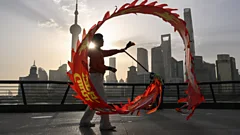
image source,AFP via Getty Images
The Communist Party of China will hold the Fourth Plenary Session of the 20th Central Committee in Beijing for four consecutive days starting this Monday (October 20). One of the items on the agenda is to review the “15th Five-Year Plan”, China's 15th “Five-Year Plan”, which covers the economic development blueprint from 2026 to 2030 and is regarded as a bellwether for outsiders to observe China's economic direction.
BBC Chinese interviewed scholars and analysts from different backgrounds to analyze the background of the “Five-Year Plan” and try to answer whether it is an economic blueprint of the central government or a political tool? How the Chinese Communist Party leader Xi Jinping deploys his “security pattern” through “planning” to respond to different dilemmas.
At the same time, the outside world also focused on the personnel adjustments within the party revealed at the Fourth Plenary Session of the Central Committee of the Communist Party of China. It was originally expected that the punishment of some senior officials would be implemented during the session. It was finally announced before the meeting on October 17 that nine senior military officials, including He Weidong and Miao Hua, were expelled from the party and the military for serious violations of discipline and law.
Time to review “plans”
Each Central Committee of the Communist Party of China usually holds about seven meetings during its five-year term. According to the Party Constitution, the “Central Plenary Session” is held at least once a year. Generally speaking, the Chinese Communist Party is accustomed to reviewing the five-year plan at the Fifth Plenary Session of the Central Committee of the Communist Party of China and formally releasing it at the National People's Congress the following year.
There have been speculations that the early review of the five-year plan at the Fourth Plenary Session of the Central Committee of the Communist Party of China is a break from convention. It is probably related to the increasingly severe economic situation. Beijing cannot wait until next year to propose policy directions to rescue the economy.
Alexander Davey, an analyst at the Mercator Institute for China Studies (MERICS) in Europe, told BBC Chinese that the reason for this unusualness is that the Third Plenary Session of the Central Committee of the Communist Party of China was inexplicably delayed, resulting in the postponement of the CCP Plenary Session cycle.
According to the practice of the past four decades, the Third Plenary Session of the current Central Committee was originally expected to be held in the year after the Party Congress, that is, in the autumn of 2023. It was eventually postponed for nearly a year to July last year. The “14th Five-Year Plan” will be completed this year and cannot be reviewed until the Fifth Plenary Session of the Central Committee in 2026.
In fact, the China Development and Reform Commission has launched preliminary research on the “15th Five-Year Plan” as early as the end of 2023; in July this year, the Political Bureau of the Central Committee decided to study the “15th Five-Year Plan” during the Fourth Plenary Session of the Central Committee of the Communist Party of China in October. The Politburo document pointed out that “the development environment is facing profound and complex changes, strategic opportunities and risks and challenges coexist, and uncertain and unpredictable factors are increasing.”
By the end of September, the Political Bureau of the CPC Central Committee released the summary of the meeting, determined the date of the Fourth Plenary Session, and mentioned the six “insistences” during the “15th Five-Year Plan” period. It stressed that “upholding the party's comprehensive leadership” should run through “all aspects and the entire process,” and pointed out that “the new security pattern guarantees the new development pattern.”

image source,AFP via Getty Images
The CCP’s “Security Pattern”
Xia Ming, a political science professor at the City University of New York in the United States, analyzed to BBC Chinese that the guiding principle in the “15th Five-Year Plan” is that the “security pattern” of the entire country needs to lead the “development pattern”, which means “political leadership”.
He said that according to the thinking of “the party leads everything”, “the economy is a collaborator and collaborator that serves the party's highest interests and goals.” The current economic inefficiency has brought a political crisis to Xi Jinping. He believes that this time's plan will have a very strong political color and is also a response to related crises.
Xia Ming pointed out that Xi Jinping has served as the General Secretary of the Communist Party of China since 2012 and became the President of China the following year. However, in the past, Li Keqiang, who belonged to a different faction, led the economic policy and was more inclined to market-driven economy. Currently, Li Qiang, Premier of the State Council, and He Li, Vice Premier in charge of economy Feng is a close confidant of Xi. He is more than halfway through his term and has become familiar with various departments. Therefore, he described the “15th Five-Year Plan” as the “first five-year plan for Xi Jinping's team to fully take charge of China's economy.” It is expected to be dominated by a mixed economy, integrating the private economy into the state-owned economy, and having more state control.
On the occasion of the 100th anniversary of the founding of the Communist Party of China, that is, in 2021, Xi Jinping has announced that he has built a moderately prosperous society in all respects. Subsequently, the Communist Party of China emphasized that it would use the three plans of the “14th Five-Year Plan”, the “15th Five-Year Plan” and the “16th Five-Year Plan” to basically achieve socialist modernization by 2035. The “15th Five-Year Plan” was described as a critical five-year link between the past and the future.
Xia Ming said that the so-called key is that Xi Jinping is currently in his third term. 2027 is an important time point. The Communist Party of China will hold its 21st Congress. The same year is also the 100th anniversary of the founding of the People's Liberation Army. “If there are no achievements in national reunification or economic well-off, then Xi Jinping will obviously not be able to enter his fourth term in 2027.”
Xia Ming believes that Xi Jinping is anxious about this, coupled with geopolitical insecurity, and Xi Jinping has already “securitized” various affairs in the past. National security is also based on economic security. It is estimated that the strategic pillar industries of the “15th Five-Year Plan” will focus on military industry or technology fields such as defense industry, aerospace, and chips. The global military competition will intensify internationally, leading to insecurity in neighboring countries and instability in the region. However, it can also maintain Xi Jinping's international strategic image and security, and at the same time “shock the Chinese people” through related developments.
Liu Ruishuo, a Hong Kong current affairs commentator who is familiar with China affairs, believes that although the “Five-Year Plan” involves the manifestation of the power of the CCP and reflects the power distribution of decision-makers, the focus is still on economic planning. He also pointed out that in the context of intensified friction between China and the United States, the outside world pays attention to the contradiction between China and the world on economic issues, and the importance of the “Five-Year Plan” is getting stronger and stronger. “Because in China, whether it is high-level officials or private people, everyone cares more about economic issues and people's livelihood issues than politics.”
However, Liu Ruishao said that Xi Jinping's power is still stable and there are currently no major political disputes. He believes that the focus of the “15th Five-Year Plan” is still on the economy. Even if the country is facing severe economic difficulties and public resentment has emerged, there are no obvious signs that it is approaching the critical point of outbreak. Therefore, he believes that “the regime will not collapse” because the government will use administrative or even dictatorial means to implement policies or suppress opposition voices.
The Soviet Union’s “Five-Year Plan”
The CCP began to implement the first Five-Year Plan in 1953, the fourth year after its founding. It has compiled a total of 14 Five-Year Plans to date, which were interrupted from 1963 to 1965 due to economic adjustment. Since 2006, the word “plan” has been changed to “planning”, which continues to this day. The planning description covers the economic vision and development goals, as well as China's major construction projects and productivity distribution in the next five years.
Liu Ruishao explained that the “Five-Year Plan” was originally planned to be a top-down planned economy for China's economy every five years. However, because the plan could not adapt to the constantly changing economic conditions, it was renamed “Planning”, which is relatively flexible and adjustable.
Chinese officials describe the “Five-Year Plan” as an important way for the party to govern the country. Articles on China's internal interpretation of the plan have repeatedly cited foreign scholars who pointed out that while China is formulating plans for the next generation, Western countries are planning for the next election to highlight the advantages of the “Five-Year Plan”, which is difficult for the West to match.
The “Five-Year Plan” has a strong political and economic style of the former Soviet Union.
Xu Chenggang, a senior researcher at the Center for Chinese Economics and Institutions at Stanford University, explained that the “Five-Year Plan” is definitely not the “industrial policy” mistakenly believed by the public, but comes from the Soviet Union and is part of the party's control of the national economy. It is based on the socialist system – that is, the party leads everything, and important and critical assets are “state-owned.”
“When the party and the country design and implement this thing, they serve the long-term strategy of the Chinese Communist Party,” Xu Chenggang said. He also pointed out that when planning requires a large amount of capital investment, it is all state-owned funds. For example, most of the funds currently invested in the development of artificial intelligence are state-owned funds.
Looking back on recent plans, the State Council announced a manufacturing industry policy called “Made in China 2025” in 2015, which was later included in the “13th Five-Year Plan”. Xu Chenggang pointed out that this situation is not the market economy, but the need to meet pre-planned quantitative standards according to the plan. The result of “Made in China 2025” is indeed to let China control many global industrial chains. But he said that when analyzing and evaluating the effectiveness of policies, the question of “what are these things made for” is ignored, and the focus is on economic development or social welfare security.

image source,Getty Images
Paradoxical economic solution
On the eve of the Fourth Plenary Session of the Central Committee of the Communist Party of China, Li Qiang held a symposium of experts and entrepreneurs on the economic situation, asking experts to “actively provide suggestions for doing a good job in economic work and promoting the development of the 15th Five-Year Plan.” During the period, he also said that we must continue to work hard to expand domestic demand, strengthen the domestic cycle, and continuously form new growth points to expand domestic demand.
According to data from the National Bureau of Statistics of China, the Consumer Price Index (CPI) and Producer Price Index (PPI) continue to fall.
Xu Chenggang analyzed that the index recorded negative growth, indicating that China is currently facing deflation that has lasted for more than two years, which is a very serious economic crisis. He pointed out that when people expect prices to continue to fall, consumers or investors will also choose to “hold money to buy. Even if you have money, try not to buy.” “No consumption and no investment means insufficient domestic demand,” further exacerbating deflation.
He believes that the “15th Five-Year Plan” is likely to focus resources on developing technology because of the need to compete with the United States. However, when the national deficit is serious and local debts are serious, continuing to invest in technology will not promote economic growth, because the current problem lies in “insufficient demand”, not “insufficient supply”, and has nothing to do with the development of high-end technology.
He said that China's investment plans and strategic layout occupy part of the industrial chain and show that it is technically capable, “but in fact it conflicts with its own economy.” “The system ruled by the Communist Party has never truly regarded domestic demand as its purpose.”
David from the Mercator China Institute analyzed that the “15th Five-Year Plan” will focus on “new productivity” and manufacturing as the driving force of economic growth; in addition, to deal with the technological “stuck” problem that the United States may impose on China, promoting domestic consumption by solving inequality problems will be the focus, and social governance will also be improved to maintain internal social stability, which will play an important role in the case of continued economic pressure.
He pointed out that planning is not an economic blueprint that must be strictly followed, but an important roadmap. Specific targets are expected to be rolled out one after another. If the plan mentions adjustment measures to boost the economy in the short term, it may mean that China will show a more flexible or willing to negotiate on the international stage.
It is worth noting that after the Fourth Plenary Session of the Central Committee of the Communist Party of China, the Asia-Pacific Economic Cooperation Organization will hold a summit in South Korea soon.
U.S. President Trump is expected to attend. In a recent interview, he stated that he would meet with Xi Jinping locally within two weeks. He also said that 100% tariffs are unsustainable.

image source,Getty Images





